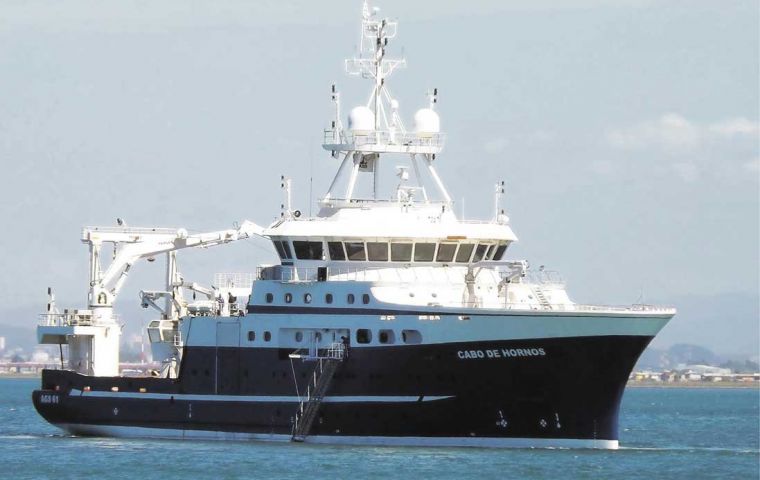MercoPress. South Atlantic News Agency
Chile’s latest scientific vessel on a hake spawning research cruise in the extreme south
 State of the art Cabo de Hornos can remain static at sea and its engines are hardly perceptible
State of the art Cabo de Hornos can remain static at sea and its engines are hardly perceptible Chile latest fisheries scientific research vessel ‘Cabo de Hornos’ has completed a month long cruise in the southern coast of the country collecting information on three different type of hake spawning, something which hadn’t been done since at least 1996, according to the country’s fisheries officials.
Cabo de Hornos in considered state of the art and one of five world class scientific vessels which can to oceanographic, hydrographical and fisheries sustainability research, with crew accommodation for 41 and 25 scientists, remaining at sea for 260 days.
She was built at a cost of 67.5 million dollars, 51 million supplied by the Chilean navy and the rest by the Fisheries and Aquaculture Department.
On her inauguration Deputy head of Fisheries and Aquaculture, Pablo Galilea said that Cabo de Hornos “responds to the Chilean government’s need to renew its oceanographic and fisheries research fleet, and will help comply with the new Fisheries and Aquaculture law based on sustainability and for which update reliable information is crucial”.
She is a very silent last generation vessel with an acoustic norm ICES 209 which means it can rest static over schools of fish, which also helps to save on deep water cables, plus a retractile keel with highly sophisticated sensors.
Cabo de Hornos first major task was precisely a scientific cruise off Magallanes and Aysen regions in extreme south of Chile to collect information on spawning by hoki, southern hake and southern blue whiting, a job which was pending since at least 1996 said Galilea.
The design and blueprints were contracted with Norway’s Skipstekniks, world leading experts in the matter, and the construction was done at the Chilean navy’s yards, Asmar. The management and command of Cabo de Hornos is responsibility of the Chilean navy while all the scientific research depends from Fisheries and Aquaculture.
As of this month and until the end of November, Cabo de Hornos will be operating in Easter Island collecting data on the sea bed as part of supplying Chile with sufficient information to claim bottom of the sea resources before the UN Law of the Sea commission.
Finally at the end of the year, from December 1 to 8, Cabo de Hornos will be doing maintenance of the DART buoys which alert on tsunamis. A challenging task which only the latest technology can address since this equipment is located at 5.000 metres in deep sea.




Top Comments
Disclaimer & comment rules-

-

Read all commentsnice work, Asmar!
Sep 17th, 2013 - 10:01 am 0Meanwhile the Irizar in Argentinian Tandanor Shipyard... *cri-cri* *cri-cri*
@1
Sep 17th, 2013 - 03:24 pm 0I agree.
It is great to see this kind of steady increase in technical capacity.
Commenting for this story is now closed.
If you have a Facebook account, become a fan and comment on our Facebook Page!